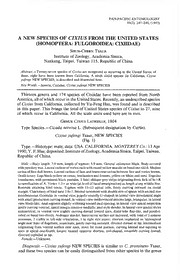
A new species of Cixius from the United States (Homoptera: Fulgoroidea: Cixiidae) PDF
Preview A new species of Cixius from the United States (Homoptera: Fulgoroidea: Cixiidae)
PAN-PACIFIC ENTOMOLOGIST 69(3): 247-249, (1993) A NEW SPECIES OF CIXIUS FROM THE UNITED STATES (HOMOPTERA: FULGOROIDEA: CIXIIDAE) Shun-Chern Tsaur Institute of Zoology, Academia Sinica, Nankang, Taipei, Taiwan 115, Republic of China Abstract.— Twenty-seven species of Cixius are recognized as occurring in the United States; of these, eight have been known from California. A ninth cixiid species for California, Cixius yufengi NEW SPECIES, is described and illustrated here. Key Words.—Insecta, Cixiidae, Cixius yufengi NEW SPECIES Thirteen genera and 174 species of Cixiidae have been reported from North America, all of which occur in the United States. Recently, an undescribed species of Cixius from California, collected by Yu-Feng Hsu, was found and is described in this paper. This brings the total of United States species of Cixius to 27, nine of which occur in California. All the scale units used here are in mm. Genus Cixius Latreille, 1804 Type Species. — Cicada nervosa L. (Subsequent designation by Curtis). Cixius yufengi Tsaur, NEW SPECIES (Fig. 1) Type.—Holotype: male; data: USA. CALIFORNIA. MONTEREY Co.: 13 Apr 1990, Y. F. Hsu; deposited: Institute of Zoology, Academia Sinica, Taipei, Taiwan, Republic of China. Male.—Body length: 7.0 mm; length of tegmen: 5.9 mm. General coloration black. Body covered with powdery wax. Lateral carinae of vertex each with round yellow macula on basal one-third. Median carina of face dull brown. Lateral carinae of face and transverse carina between face and vertex brown. Ocelli tawny. Legs black-yellow on coxae, trochanters and femora, yellow on tibiae and tarsi. Tegmina translucent, with prominent black pustules, 1 faint oblique grey stripe originating from fork of Sc+R to ramification of A. Vertex 1.3 x as wide (at level of basal emargination) as length along middle line. Rostrum attaining hind coxae. Tegmen with 11-12 apical cells, finely curving outward on costal margin. Chaetotaxy of hind tarsi 7/6-7. Second tarsomere with double row of spines with second row membraneous. Genitalia: in ventral view, pygofer roundly U-shaped; in lateral view dorsolateral angle with small production curving mesad, in ventral view medioventral process large, triangular, in lateral view blade-like. Anal segment slightly widening toward anal opening, in lateral view apical projection gently curving ventrad, apical margin concave medially, anal style slender. In lateral view genital styles symmetrical, in ventral view slightly curving dorsad toward apex, distal lobe flap-like, and parallel¬ sided on basal two-thirds. Aedeagus slender, basoventral surface not indented, with total of 3 spinose processes, 2 visible in left-side orientation, 1 in right side aspect: shortest implanted on lateroapical angle near base of flagellum, acuminate, gently curving outward, directed dorsad at tip; intermediate originating from ventral surface near apex, stout for most portion, curving laterad and tapering to apex at apical one-fourth; longest located opposite shortest, awl-shaped, smoothly curving dorsad, directed cephalad at tip. Female.—Unknown. Diagnosis. —Cixius yufengi NEW SPECIES is similar to C. prominens Tsaur, and these two species can be easily distinguished from other species in the genus 248 THE PAN-PACIFIC ENTOMOLOGIST Vol. 69(3) Figure 1. Male genitalia of Cixius yufengi NEW SPECIES. A, Left lateral view of pygofer, anal segment and anal style; B, ventral view of pygofer and genital styles; C-D, aedeagus; C, left lateral view; D, ventral view; E, anal segment, caudal view. 1993 TSAUR: A NEW SPECIES OF CIXIUS 249 in that each bears a prominent production in lateral view. These 2 species may be separated by aedeagal pattern, which, for C. yufengi, is shown in Fig. 1: C, D. Distribution. — United States (California). Etymology. — This new species is named after the collector of the holotype, Yu- Feng Hsu. Material Examined.—See type. Acknowledgment I am grateful to Yu-Feng Hsu, University of California, Berkeley, for sending me the material for this work. Cordial thanks go to Fei-Jann Lin, Academia Sinica, Republic of China, for reading the manuscript. This study was funded by a postdoctoral fellowship from the National Science Council, Republic of China (NSC grant 79-0211-B001-31). Literature Cited Kramer, J. P. 1981. Taxonomic study of the planthopper genus Cixius in the United States and Mexico (Homoptera: Fulgoroidea: Cixiidae). Trans. Am. Entomol. Soc., 107: 1-68. Kramer, J. P. 1983. Taxonomic study of the planthopper family Cixiidae in the United States (Homoptera: Fulgoroidea). Trans. Am. Entomol. Soc., 109: 1-58. Tsaur, S. C. 1990. Two new species of Cixius from California (Homoptera: Fulgoroidea: Cixiidae), with a revised key to the species of the genus. Bull. Inst. Zool., Academia Sinica, 29(1): 49-55. Received 24 June 1992; accepted 1 March 1993.
